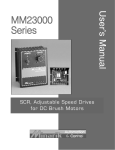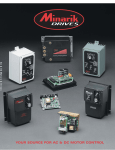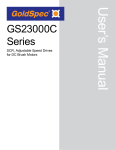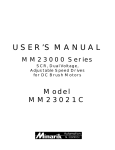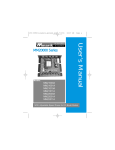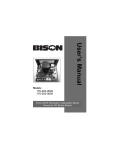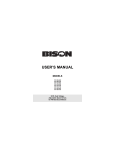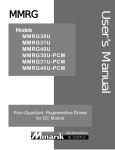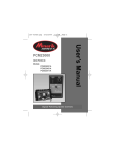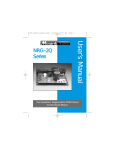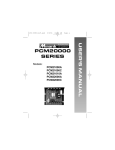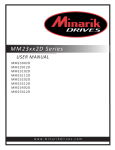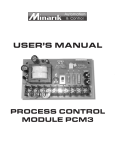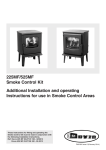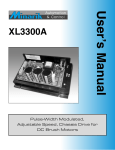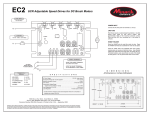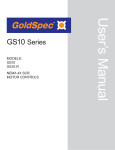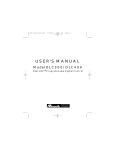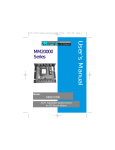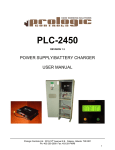Download USER`S MANUAL
Transcript
250-0100 rev 3.qxd 3/12/99 12:40 PM Page I USER’S MANUAL SCR Filtered Series Filtered SCR, Adjustable Speed Drives for DC Brush Motors Models: MM21051C MM21151C MM21251C 250-0100 rev 3.qxd 3/12/99 12:40 PM Page II Copyright 1998 by Minarik Corporation All rights reserved. No part of this manual may be reproduced or transmitted in any form without written permission from Minarik Corporation. The information and technical data in this manual are subject to change without notice. Minarik Corporation and its Divisions make no warranty of any kind with respect to this material, including, but not limited to, the implied warranties of its merchantability and fitness for a given purpose. Minarik Corporation and its Divisions assume no responsibility for any errors that may appear in this manual and make no commitment to update or to keep current the information in this manual. Printed in the United States of America. 250-0100 rev 3.qxd 3/12/99 12:40 PM Page i Safety Warnings m • This symbol denotes an important safety tip or warning. Please read these sections carefully prior to performing any of the instructions contained in that section. • Have a qualified electrical maintenance technician install, adjust and service this equipment. Follow the National Electrical Code and all other applicable electrical and safety codes, including the provisions of the Occupational Safety and Health Act (OSHA), when installing equipment. • Reduce the chance of an electrical fire, shock, or explosion by proper grounding, over-current protection, thermal protection, and enclosure. Follow sound maintenance procedures. • It is possible for a drive to run at full speed as a result of a component failure. Please ensure that a master switch has been placed in the AC line to stop the drive in an emergency. • This drive is isolated from earth ground. Circuit potentials are at 115 VAC or 230 VAC above earth ground. Avoid direct contact with the printed circuit board or with circuit elements to prevent the risk of serious injury or fatality. Use a nonmetallic screwdriver for adjusting the calibration trimpots. 250-0100 rev 3.qxd 3/12/99 12:40 PM Page ii ii Contents Specifications 1 Dimensions 2 Installation 5 Mounting chassis drives . . . . . . . . . . . . . . . . . . . . . . . . . . . . . . . . . . . . . . .5 Mounting cased drives . . . . . . . . . . . . . . . . . . . . . . . . . . . . . . . . . . . . . . . .6 Wiring . . . . . . . . . . . . . . . . . . . . . . . . . . . . . . . . . . . . . . . . . . . . . . . . . . . . .8 Heat sinking . . . . . . . . . . . . . . . . . . . . . . . . . . . . . . . . . . . . . . . . . . . . . . . .9 Line fuses . . . . . . . . . . . . . . . . . . . . . . . . . . . . . . . . . . . . . . . . . . . . . . . . . .9 Field output . . . . . . . . . . . . . . . . . . . . . . . . . . . . . . . . . . . . . . . . . . . . . . . .10 AC line and motor connection (MM21051C) . . . . . . . . . . . . . . . . . . . . . . .11 AC line and motor connection (MM21151C/MM21251C) . . . . . . . . . . . . . .11 Screw terminal block . . . . . . . . . . . . . . . . . . . . . . . . . . . . . . . . . . . . . . . . .13 Speed adjust potentiometer installation . . . . . . . . . . . . . . . . . . . . . . . . . . .14 Voltage follower . . . . . . . . . . . . . . . . . . . . . . . . . . . . . . . . . . . . . . . . . . . .15 Operation 16 Before applying power . . . . . . . . . . . . . . . . . . . . . . . . . . . . . . . . . . . . . . .16 Startup . . . . . . . . . . . . . . . . . . . . . . . . . . . . . . . . . . . . . . . . . . . . . . . . . . .16 MM21051C . . . . . . . . . . . . . . . . . . . . . . . . . . . . . . . . . . . . . . . . . . .16 MM21151C . . . . . . . . . . . . . . . . . . . . . . . . . . . . . . . . . . . . . . . . . . .16 MM21251C . . . . . . . . . . . . . . . . . . . . . . . . . . . . . . . . . . . . . . . . . . .17 Line starting and line stopping . . . . . . . . . . . . . . . . . . . . . . . . . . . . . . . . . .18 Automatic restart upon power restoration . . . . . . . . . . . . . . . . . . . . . . . . .18 Inhibit circuit . . . . . . . . . . . . . . . . . . . . . . . . . . . . . . . . . . . . . . . . . . . . . . .18 Inhibit terminal accessories . . . . . . . . . . . . . . . . . . . . . . . . . . . . . . . . . . . .19 Decelerating to minimum speed . . . . . . . . . . . . . . . . . . . . . . . . . . . . . . . .20 250-0100 rev 3.qxd 3/12/99 12:40 PM Page iii Contents iii Dynamic braking . . . . . . . . . . . . . . . . . . . . . . . . . . . . . . . . . . . . . . . . . . . .21 Warning . . . . . . . . . . . . . . . . . . . . . . . . . . . . . . . . . . . . . . . . . . . . . . . . . .21 Calibration 23 MIN SPD . . . . . . . . . . . . . . . . . . . . . . . . . . . . . . . . . . . . . . . . . . . . . . . . .24 MAX SPD . . . . . . . . . . . . . . . . . . . . . . . . . . . . . . . . . . . . . . . . . . . . . . . . .24 ACCEL . . . . . . . . . . . . . . . . . . . . . . . . . . . . . . . . . . . . . . . . . . . . . . . . . . .24 DECEL . . . . . . . . . . . . . . . . . . . . . . . . . . . . . . . . . . . . . . . . . . . . . . . . . . .25 IR COMP . . . . . . . . . . . . . . . . . . . . . . . . . . . . . . . . . . . . . . . . . . . . . . . . .25 TORQUE . . . . . . . . . . . . . . . . . . . . . . . . . . . . . . . . . . . . . . . . . . . . . . . . .26 Application Notes 28 Multiple fixed speeds . . . . . . . . . . . . . . . . . . . . . . . . . . . . . . . . . . . . . . . .28 Adjustable speeds using potentiometers in series . . . . . . . . . . . . . . . . . . .29 Independent adjustable speeds . . . . . . . . . . . . . . . . . . . . . . . . . . . . . . . . .30 RUN/JOG switch . . . . . . . . . . . . . . . . . . . . . . . . . . . . . . . . . . . . . . . . . . . .31 Reversing . . . . . . . . . . . . . . . . . . . . . . . . . . . . . . . . . . . . . . . . . . . . . . . . .33 Leader–Follower application . . . . . . . . . . . . . . . . . . . . . . . . . . . . . . . . . . .34 Single speed potentiometer control of multiple drives . . . . . . . . . . . . . . . .35 Functional Diagrams 36 Troubleshooting 39 Certificate of Compliance - CE Mark 40 Replacement Parts 43 Limited Warranty inside back cover 250-0100 rev 3.qxd iv 3/12/99 12:40 PM Page iv 250-0100 rev 3.qxd 3/12/99 12:40 PM Page 1 1 Specifications Maximum Model AC Line Armature Voltage Current Single Phase (Amps DC) HP Range 50/60 Hz 2.7 1/20–1/4 115VAC (–5%,+10%) MM21X51C Armature Voltage (115 VAC Input) 0–130VDC Form Factor Field Voltage 1.05 at base speed 50 VDC (F1 to L1); 100 VDC (F1 to F2) Max. Field Current 1 ADC Accel. Time Range (0–130 VDC Armature Voltage) 0.5 – 7 seconds Decel. Time Range (0–130VDC Armature Voltage) 0.5 – 7 seconds Analog Input Voltage Range (0–130VDC Armature Voltage)* Input Impedance (S1 to S2) Load Regulation 0 – 5.7 VDC 45KΩ 3% of base speed or better Ambient Temp. Range MM21051C MM21151C, MM21251C Vibration 10°C–55°C 10°C–40°C 0.5 G max. (20 – 50 Hz) 0.1 G max. (>50 Hz) Weight MM21051C 2.1 lb (953 g) MM21151C, MM21251C 3.3 lb (1.5 kg) Style MM21051C MM21151C, MM21251C * Isolated terminals S1 to S2 chassis NEMA 1 250-0100 rev 3.qxd 3/12/99 12:40 PM Page 2 2 Dimensions All dimensions in inches [mm] Figure 1. MM21051C Dimensions 250-0100 rev 3.qxd 3/12/99 12:40 PM Page 3 Dimensions All dimensions in inches [mm] Figure 2. MM21151C Dimensions 3 250-0100 rev 3.qxd 4 3/12/99 12:40 PM Page 4 Dimensions All dimensions in inches [mm] Figure 3. MM21251C Dimensions 250-0100 rev 3.qxd 3/12/99 12:40 PM Page 5 5 Installation Drive mounting (General) •Drive components are sensitive to electrostatic fields. Avoid direct contact with the circuit board. Hold the drive by the chassis only. •Protect the drive from dirt, moisture, and accidental contact. Provide sufficient room for access to the terminal block and calibration trimpots. •Mount the drive away from heat sources. Operate the drive within the specified ambient operating temperature range. •Prevent loose connections by avoiding excessive vibration of the drive. Drive mounting (Chassis drives) •Mount the drive with its board in either a horizontal or vertical plane. Eight 0.188 inch (4.8 mm) wide slots in the chassis accept #8 pan head screws. Fasten either the large base or the narrow flange of the chassis to the subplate. •The drive must be earth grounded for noise suppression. Connect earth ground to the earth ground terminal on the drive’s bottom board (see Connections). 250-0100 rev 3.qxd 6 3/12/99 12:40 PM Page 6 Installation Drive mounting (Cased drives) Cased drives come with 0.88 inch (22 mm) conduit holes at the bottom of the case. The units may be vertically wall mounted or horizontally bench mounted using the three keyholes on the back of the case. See Figure 5 for mounting hole locations. 1. For access to the keyholes and the terminal strip, remove the two screws from the front of the case by turning them counterclockwise. Grasp the front cover and lift it straight out. 2. Install the mounting screws in the three keyholes. 3. Install conduit hardware through the conduit holes at the bottom of the case. Connect external wiring to the terminal block. 4. Reinstall the front cover. Avoid pinching any wires between the front cover and the case. 5. Replace the two screws to the front cover. Turn the screws clockwise to tighten. 6. Set the POWER switch to the OFF position before applying AC line voltage. 250-0100 rev 3.qxd 3/12/99 12:40 PM Page 7 Installation Figure 4. MM21151C and MM21251C Back View Cased Mounting Keyhole Locations 7 250-0100 rev 3.qxd 8 3/12/99 12:40 PM Page 8 Installation Wiring • Use 18 AWG wire for speed adjust potentiometer wiring. Use 16 AWG wire for AC line (L1, L2) and motor (A1, A2) wiring. Shielding guidelines As a general rule, Minarik recommends shielding of all conductors if: 1) wire lengths exceed 18 inches, with separation of power and logic leads; 2) wire lengths exceed 4 inches and power and logic leads must be bundled together*; 3) radiated and/or conducted noise must be minimized due to concerns about immunity or general compliance (CE, FCC, etc.) *Minarik considers this an unfavorable condition and does not recommend bundling of power and logic leads for any length. m If it is not practical to shield power conductors, Minarik recommends shielding all logic-level leads. If shielding is not practical, the user should twist all logic leads with themselves to minimize induced noise. m ( Under no circumstances should power and logic leads be bundled together. Induced voltage can cause unpredicatable behavior any electronic device, including motor controls. It may be necessary to earth ground the shielded cable. If noise is produced by devices other than the drive, ground the shield at the 250-0100 rev 3.qxd 3/12/99 12:40 PM Page 9 Installation 9 drive end. If noise is generated by a device on the drive, ground the shield at the end away from the drive. Do not ground both ends of the shield. If the drive continues to pick up noise after grounding the shield, it may be necessary to add AC line filtering devices, or to mount the drive in a less noisy environment. m Do not disconnect any of the motor leads from the drive unless power is removed or the drive is disabled. Opening any one motor lead may destroy the drive. Heat sinking All MM21X51C drives have sufficient heat sinking in their basic configurations. No additional heat sinking is required. Line fuses All drives have line fuses installed (see Replacement Parts section for installed line fuse size). Line fuses are rated for maximum rated horsepower. Fuse L1 when using 115 VAC line voltage. Table 2. Recommended Line Fuse Sizes MOTOR HP 1/20 1/8 1/4 FUSE SIZE (AMPS) @115VAC INPUT 5 8 8 250-0100 rev 3.qxd 10 3/12/99 12:40 PM Page 10 Installation Field output The field output is for shunt wound motors only. Do not make any connections to F1 and F2 when using a permanent magnet motor. Use 16 AWG wire to connect the field output to a shunt wound motor. Table 1 lists the field output connections. Table 1. Field Output Connections Approximate Field Voltage (VDC) 50 100 Connect Motor Field To F1 and L1 F1 and F2 250-0100 rev 3.qxd 3/12/99 12:40 PM Page 11 Installation 11 Connections (MM21051C) ASSUMPTIONS: Minarik drives supply motor voltage from A1 and A2 terminals. It is assumed throughout this manual that, when A1 is positive with respect to A2, the motor will rotate clockwise (CW) while looking at the output shaft protruding from the front of the motor. If this is opposite of the desired rotation, simply reverse the wiring of A1 and A2 with each other. NOTE: DO NOT CONNECT FIELD COILS IF USING PERMANENTMAGNET MOTOR Figure 5. MM21051C Drive Connections 250-0100 rev 3.qxd 12 3/12/99 12:40 PM Page 12 Installation Connections (MM21151C and MM21251C) ASSUMPTIONS: Minarik drives supply motor voltage from A1 and A2 terminals. It is assumed throughout this manual that, when A1 is positive with respect to A2, the motor will rotate clockwise (CW) while looking at the output shaft protruding from the front of the motor. If this is opposite of the desired rotation, simply reverse the wiring of A1 and A2 with each other. NOTE: DO NOT CONNECT FIELD COILS IF USING PERMANENTMAGNET MOTOR Figure 6. MM21151C and MM21251C Connections 250-0100 rev 3.qxd 3/12/99 12:40 PM Page 13 Installation 13 Screw terminal block Connections to these drives are made to a screw terminal block (Figure 7). The chassis model (MM21051C) has 9 screws on the terminal block. The cased models (MM21151C, and MM21251C) have 7 screws on the terminal block. Using a screwdriver, turn the terminal block screw counter-clockwise to open the wire clamp. Insert stripped wire into the wire clamp. Turn the terminal block screw clockwise to clamp the wire. Terminal Block Screw Wire Clamp Figure 7. Screw Terminal Block 250-0100 rev 3.qxd 14 3/12/99 12:40 PM Page 14 Installation Speed adjust potentiometer installation Speed adjust potentiometers are pre-installed on all cased drives. On chassis drives, install the circular insulating disk between the panel and the 10KΩ speed adjust potentiometer. Mount the speed adjust potentiometer through a 0.38 inch (0.96 cm) hole with the hardware provided (see Figure 8). Twist the speed adjust potentiometer wires to avoid picking up unwanted electrical noise. If potentiometer leads are longer than 18 inches (46 cm), use shielded cable. Do not bundle potentiometer wires with AC power leads. m Warning Be sure that the potentiometer tabs do not make contact with the panel. Grounding the input will cause damage to the drive. Figure 8. Speed Adjust Potentiometer 250-0100 rev 3.qxd 3/12/99 12:40 PM Page 15 Installation 15 Voltage follower Instead of using a speed adjust potentiometer, the drive may be wired to follow an analog input voltage signal that is isolated from earth ground (Figure 9). Connect the signal input (+) to S2. Connect the signal common (–) to S1. Make no connection to S3. A potentiometer can be used to scale the analog input voltage. To achieve isolation, use an interface device such as Minarik® model PCM4 to scale the analog input voltage. Figure 9. Voltage Follower Connections 250-0100 rev 3.qxd 3/12/99 12:40 PM Page 16 16 Operation Before applying power 1. Check connections before applying AC line voltage to the drive. 2. Check that no conductive material is present on the printed circuit board. Startup MM21051C 1. Turn the speed adjust potentiometer full counterclockwise (CCW). 2. Apply AC line voltage. 3. Slowly advance the speed adjust potentiometer clockwise (CW). The motor slowly accelerates as the potentiometer is turned CW. Continue until the desired speed is reached. 4. Remove AC line voltage from the drive to coast the motor to a stop. MM21151C 1. Turn the speed adjust potentiometer full counterclockwise (CCW). 2. Apply AC line voltage 3. Set the POWER switch to the ON position. 4. Slowly advance the speed adjust potentiometer clockwise (CW). The motor slowly accelerates as the potentiometer is turned CW. Continue until the desired speed is reached. 250-0100 rev 3.qxd 3/12/99 12:40 PM Page 17 Operation 17 5. Set the POWER switch to the OFF position to coast the motor to a stop. MM21251C 1. Set the RUN/STOP switch to the STOP position. 2. Turn the speed adjust potentiometer full counterclockwise (CCW). 3. Apply AC line voltage. 4. Set the POWER switch to the ON position. 5. Set the FWD/REV switch to the desired direction of rotation. 6. Set the RUN/STOP switch to the RUN position. 7. Slowly advance the speed adjust potentiometer clockwise (CW). The motor slowly accelerates as the potentiometer is turned CW. Continue until the desired speed is reached. 8. To stop the motor set the RUN/STOP switch to the STOP position. 9. To reverse direction: a. Set the RUN/STOP switch to the STOP position. b. Set the FWD/REV switch to the desired direction of rotation. c. Set the RUN/STOP switch to the RUN position. m Warning Do not change the FWD/REV switch while the motor is running. The motor must come to a complete stop before reversing. Changing motor direction before allowing the motor to completely stop will cause excessively high current to flow in the armature circuit, and will damage the drive and/or motor. 250-0100 rev 3.qxd 18 3/12/99 12:40 PM Page 18 Operation Line starting and line stopping Line starting and line stopping (applying and removing AC line voltage) is recommended for infrequent starting and stopping of a drive only. When AC line voltage is applied to the drive, the motor accelerates to the speed set by the speed adjust potentiometer. When AC line voltage is removed, the motor coasts to a stop. Automatic restart upon power restoration All drives automatically run to set speed when power is applied. Wiring a latching relay into the AC line is one way to prevent automatic restarting following a power outage. Inhibit circuit (MM21051C ONLY) Maintaining a connection between the inhibit pins causes the motor to coast to zero speed. Removing the connection between the inhibit pins allows the motor to accelerate to the speed set by the speed adjust potentiometer (Figure 10). m Warning The inhibit circuit is used for frequent starts and stops. It must never be used as an emergency stop. It may not stop a drive that is malfunctioning. Removing AC line power (both L1 and L2) is the only acceptable method for emergency stopping. Minarik strongly recommends the installation of a STOP/START switch for emergency stopping. 250-0100 rev 3.qxd 3/12/99 12:40 PM Page 19 Operation 19 Inhibit terminal accesories Minarik Corporation offers two accessory plug harnesses for the INHIBIT terminals: Table 3. Inhibit plug part numbers Minarik® Part Number 201-0024 201-0079 Description Inhibit plug with 18 in. (46 cm) wires Inhibit plug with 36 in. (91 cm) wires Twist inhibit wires and separate them from other powercarrying wires or sources of electrical noise. Use shielded cable if the inhibit wires are longer than 18 in. (46 cm). If shielded cable is used, ground only one end of the shield to earth ground. Do not ground both ends of the shield. Fig. 10 Inhibit Circuit Connections (MM21051C only) 250-0100 rev 3.qxd 20 3/12/99 12:40 PM Page 20 Operation Decelerating to minimum speed The circuit shown in Figure 11 may be used to decelerate a motor to a minimum speed. Closing the switch between S1 and S2 decelerates the motor from set speed to a minimum speed determined by the MIN SPD trimpot setting. If the MIN SPD trimpot is set full CCW, the motor decelerates to zero speed when the switch between S1 and S2 is closed. The DECEL trimpot setting determines the rate at which the drive decelerates. By opening the switch the motor accelerates to set speed at a rate determined by the ACCEL trimpot setting. Figure 11. Run/Decelerate to Minimum Speed Switch 250-0100 rev 3.qxd 3/12/99 12:40 PM Page 21 Operation 21 Dynamic braking Dynamic braking may be used to rapidly stop a motor (Figure 12). For the RUN/BRAKE switch, use a three pole, two position switch rated for at least 125 VDC, 6 Amps. The dynamic braking resistor should be ceramic encased, and a minimum of 25Ω, 10 watts. The motor stops less rapidly with higher brake resistor values. m Warning Wait for the motor to completely stop before switching back to RUN. This will prevent high armature currents from damaging the motor or drive. Certain Minarik® drives coast to minimum speed when the inhibit terminals are shorted to each other. IR COMP and TORQUE are still active while the drive is in the inhibit mode. For frequent starts and stops, use coasting to a stop (shorting inhibit terminal to each other – MM21051C only), decelerating to minimum speed (shorting S2 and S1 to each other), or dynamic braking. Do not use any of these methods for emergency stopping. They may not stop a drive that is malfunctioning. Removing AC line power (both L1 and L2) is the only acceptable method for emergency stopping. NOTE: Model MM21251C is equipped with dynamic braking. 250-0100 rev 3.qxd 22 3/12/99 12:40 PM Page 22 Operation Figure 12. Dynamic Braking Circuit Connection 250-0100 rev 3.qxd 3/12/99 12:40 PM Page 23 23 Calibration Each drive is factory calibrated to its maximum horsepower rating. Readjust the calibration trimpot settings to accommodate lower horsepower motors. All adjustments increase with CW rotation, and decrease with CCW rotation. Use a non-metallic screwdriver for calibration. Each trimpot is identified on the printed circuit board. MM21051C MM21151C/MM21251C Figure 13. Calibration Trimpot Layout 250-0100 rev 3.qxd 24 3/12/99 12:40 PM Page 24 Calibration MIN SPD The MIN SPD setting determines the minimum speed when the speed adjust potentiometer is turned full CCW. It is factory set to zero speed. To calibrate, set the speed adjust potentiometer full CCW. Adjust the MIN SPD trimpot until the motor has stopped, or is running at the desired minimum speed. MAX SPD MAX SPD setting determines the maximum motor speed when the speed adjust potentiometer is turned full CW. It is factory set for maximum rated motor speed. To calibrate, set the MAX SPD trimpot full CCW. Turn the speed adjust potentiometer full CW. Adjust the MAX SPD trimpot until the desired maximum motor speed is reached. ACCEL The ACCEL setting determines the time the motor takes to ramp to a higher speed, within the limits of available torque. The ACCEL setting is factory set for its fastest acceleration time. 250-0100 rev 3.qxd 3/12/99 12:40 PM Page 25 Calibration 25 Turn the ACCEL trimpot CW to increase the acceleration time, and CCW to decrease the acceleration time. DECEL The DECEL setting determines the time the motor takes to ramp to lower speed, within the limits of available torque. The DECEL setting is factory set for its fastest deceleration time. Turn the DECEL trimpot CW to increase the deceleration time, and CCW to decrease the deceleration time. IR COMP The IR COMP setting determines the degree to which motor speed is held constant as the motor load changes. It is factory set for optimum motor regulation. Recalibrate the IR COMP setting when using a lower horsepower motor. Refer to the recommend IR COMP settings below, or recalibrate using the following procedure: If the motor does not maintain set speed as the load changes, gradually rotate the IR COMP trimpot CW. If the motor speed oscillates (overcompensation), the IR COMP trimpot may be set too high (CW). Turn the IR COMP trimpot CCW until the motor speed stabilizes. 250-0100 rev 3.qxd 26 3/12/99 12:40 PM Page 26 Calibration TORQUE The TORQUE setting determines the maximum armature current output of the drive. It is factory set at 120% of rated motor current. Recalibrate the TORQUE setting when using a lower horsepower motor. Refer to the recommended TORQUE settings below, or recalibrate using the following procedure: 1. With the power disconnected from the drive, connect a DC ammeter (0-15 A minimum scale) in series with the armature. 2. Set the TORQUE trimpot to minimum (full CCW). 3. Connect power to the drive. The motor should remain stopped. 4. Lock the motor armature. Be sure that the motor is firmly mounted. 5. Set the speed adjust potentiometer to maximum (full CW). 6. Adjust the TORQUE trimpot CW slowly until the armature current is 120% of motor rated armature current. 7. Set the speed adjust potentiometer to minimum and remove the stall from the motor. m WARNING Although the TORQUE can be set to exceed the motor’s maximum armature current rating, we recommend you do not run the motor continuously beyond that rating. Continuous operation beyond the maximum armature current rating may cause thermal degradation of the motor and drive. 250-0100 rev 3.qxd 3/12/99 12:40 PM Page 27 Calibration Figure 14 Typical TORQUE and IR COMP Settings (actual settings may vary with each application) 27 250-0100 rev 3.qxd 3/12/99 12:40 PM Page 28 28 Application Notes Multiple fixed speeds Replace the speed adjust potentiometer with series resistors with a total series resistance of 10K ohms (Figure 15). Add a single pole, multi-position switch with the correct number of positions for the desired number of fixed speeds. Figure 15. Multiple Fixed Speeds 250-0100 rev 3.qxd 3/12/99 12:40 PM Page 29 Application Notes Adjustable speeds using potentiometers in series Replace the speed adjust potentiometer with a single pole, multi-position switch, and two or more potentiometers in series, with a total series resistance of 10K ohms. Figure 16 shows a connection for fixed high and low speed adjust potentiometers Figure 16. Adjustable Fixed Speeds Using Potentiometers in Series 29 250-0100 rev 3.qxd 30 3/12/99 12:40 PM Page 30 Application Notes Independent adjustable speeds Replace the speed adjust potentiometer with a single pole, multi-position switch, and two or more potentiometers in parallel, with a total parallel resistance of 10K ohms. Figure 17 shows the connection of two independent speed adjust potentiometers that can be mounted at two separate operating stations. Figure 17. Independent Adjustable Speeds 250-0100 rev 3.qxd 3/12/99 12:40 PM Page 31 Application Notes 31 RUN/JOG switch Using a RUN/JOG switch is recommended in applications where quick stopping is not needed and frequent jogging is required. Use a single pole, two position switch for the RUN/JOG switch and a single pole, normally closed, momentary operated pushbutton for the JOG pushbutton. In the first wiring option, connect the RUN/JOG switch and JOG pushbutton to the inhibit plug as shown in Figure 18. The motor coasts to a stop when the RUN/JOG switch is set to JOG. Press the JOG pushbutton to jog the motor. Return the RUN/JOG switch to RUN for normal operation. Figure 18. RUN/JOG Switch Connection to Inhibit Plug 250-0100 rev 3.qxd 32 3/12/99 12:40 PM Page 32 Application Notes In the second wiring option, connect the RUN/JOG switch and the JOG pushbutton as shown is Figure 19. When the RUN/JOG switch is set to JOG, the motor decelerates to minimum speed (minimum speed is determined by the MIN SPD trimpot setting). Press the JOG pushbutton to jog the motor. Return the RUN/JOG switch to RUN for normal operation. Figure 19. RUN/JOG Switch Connection to Speed Adjust Potentiometer 250-0100 rev 3.qxd 3/12/99 12:40 PM Page 33 Application Notes Reversing A dynamic brake may be used when reversing the motor direction (Figure 20). For the RUN/BRAKE switch, use a four pole, three position switch rated for at least 125 VDC, 6 Amps. The dynamic braking resistor should be ceramic encased, and a minimum of 25Ω, 10 watts. The motor stops less rapidly with higher brake resistor values. Wait for the motor to stop completely before switching it to either the forward or reverse direction. Figure 20. Reversing Diagram 33 250-0100 rev 3.qxd 34 3/12/99 12:40 PM Page 34 Application Notes Leader-Follower application In this application, use a PCM4 to monitor the speed of the leader motor (Figure 21). The PCM4 isolates the leader motor from the follower drive, and outputs a voltage proportional to the leader motor armature voltage. The follower drive uses this voltage reference to set the speed of the follower motor. An optional ratio potentiometer may be used to scale the PCM4 output voltage. Figure 21. Leader Follower Application 250-0100 rev 3.qxd 3/12/99 12:40 PM Page 35 Application Notes 35 Single speed potentiometer control of multiple drives Multiple drives can be controlled with a single speed adjust potentiometer using a PCM4 at the input of each drive to provide isolation (Figure 22). Optional ratio potentiometers can be used to scale the PCM4 output voltage, allowing independent control of each drive. Figure 22. Single Speed Potentiometer Control of Multiple Drives 250-0100 rev 3.qxd 3/12/99 12:40 PM Page 36 36 Figure 23. MM21051C, MM21151C, and MM21251C block diagram Functional Diagrams 250-0100 rev 3.qxd 3/12/99 12:40 PM Page 37 Functional Diagrams S1 S3 Figure 24. MM21151C switching circuit connections 37 250-0100 rev 3.qxd 38 3/12/99 12:41 PM Page 38 Functional Diagrams Figure 25. MM21251C switching circuit connections 250-0100 rev 3.qxd 3/12/99 12:41 PM Page 39 39 Troubleshooting m Warning Dangerous voltages exist on the drive when it is powered. When possible, disconnect the drive while troubleshooting. Be alert. High voltages can cause serious or fatal injury. Check the following steps before proceeding: 1. The AC line voltage must match the voltage on the drive nameplate and be balanced. 2. The motor must be rated for the drive’s rated armature (all motors) and field outputs (shunt wound motors only). 3. Do not make any connections to F1 and F2 when using a permanent magnet motor. 4. Terminal block connections should be consistent with the connections shown in this manual. 5. Check that the line fuse is properly sized and not blown. 250-0100 rev 3.qxd 40 3/12/99 12:41 PM Page 40 Troubleshooting Suggested Solutions Problem Possible Causes Line fuse blows. 1. Line fuse is the wrong 1. Check that the line fuse is correct for the size. motor size (page 14). Motor runs too fast at maximum speed setting. 2. Motor cable or armature is shorted to ground. 2. Check motor cable and armature for shorts. 1. MIN SPD and MAX SPD settings are too high. 1. Recalibrate MIN SPD and MAX SPD. 2. Motor field connections are loose (shunt wound motors only). 2. Check motor field connections and armature output voltage. 250-0100 rev 3.qxd 3/12/99 12:41 PM Page 41 Troubleshooting 41 Problem Possible Causes Suggested Solutions Line fuse does not blow, but the motor does not run. 1. Speed adjust potentiometer or voltage input signal set to zero speed. 1. Increase the speed adjust potentiometer or voltage setting. 2. Speed adjust potentiometer or voltage input signal not connected to drive input properly; connections are open. 2. Check connections to input. Verify that connections are not open. 3. S2 is shorted to S1. 3. Remove short. 4. Drive is in current limit. 4. Verify that motor is not jammed. Increase TORQUE setting, they are set too low. 5. Drive is not receiving AC line voltage. 5. Apply AC line voltage to L1 and L2. 6. Motor is not connected. 6. Connect motor to A1 and A2. 250-0100 rev 3.qxd 42 3/12/99 12:41 PM Page 42 Troubleshooting Problem Possible Causes Motor runs too slow or 1. MIN SPD and MAX too fast. SPD not calibrated. Motor will not reach the desired speed. Motor pulsates or surges under load. Suggested Solutions 1. Calibrate MIN SPD and MAX SPD. 2. Field not operating properly. 2. Check motor field connections and voltage. 1.MAX SPD setting is too low. 1. Increase MAX SPD setting. 2. IR COMP setting is too low. 2. Increase IR COMP setting. 3. Motor is overloaded. 3. Check motor load. Resize the motor if necessary. 1.IR COMP is set too high. 1. Adjust the IR COMP setting slightly CCW until the motor speed stabilizes. 2. Motor bouncing in and out of TORQUE limit. 2. Make sure motor is not undersized for load; adjust TORQUE pot CW. For further assistance, contact your Minarik distributor or the factory direct: telephone (702) 823-9475 or fax: (702) 823-9495 250-0100 rev 3.qxd 3/12/99 12:41 PM Page 43 43 Certificate of Compliance Minarik Corporation hereby certifies that its MM21151C and MM21251C drives have been approved to bear the CE mark, provided the conditions of approval (listed on page 34 and 35) have been met by the end user. The MM21151C and MM21251C have been tested to the following test specifications: EN55011:1991 (emissions), and EN50082-1:1992 (immunity) Compliance allows Minarik’s MM21151C and MM21251C series to bear the CE mark. The end user, as described herein, falls into one of two categories: 1. The Consumer will deploy a stand-alone unit as an integral, yet external, portion of the machine he/she is operating. 2. The Original Equipment Manufacturer (OEM) will implement the product as a component of the machine being manufactured. 250-0100 rev 3.qxd 44 3/12/99 12:41 PM Page 44 Certificate of Compliance - CE Mark Conditions of CE approval In addition to EMI/RFI safeguards inherent in the MM21151C and MM21251C designs, external filtering is required. Minarik requires the Corcom® filters listed in Table 4. If the exact filter is not available, the specifications are as follows: L = (1.73 + 0.03) milliHenries. C = (0.27 + 0.54) microFarads (X); 0.0055 microFarads (Y). R = 330 Kohms Rated current: 1.4 times maximum DC motor current. Filter type: Balanced 2-section Table 4. Corcom® Filters Nameplate Current of Motor Wired to the Drive 0 to 4 amps 4.1 to 13 amps Corcom® Part Number 6VV1 20VV1 The filters in Table 4 should be wired to the AC line within 0.25 meters of the drive. The ground connection from the filter must be wired to solid earth ground (resistance less than 500 ohms); not machine ground. This is very important! If the end-user is using a CE approved motor, the correct filter from Table 4 is all that is necessary to meet the EMC directives listed herein. 250-0100 rev 3.qxd 3/12/99 12:41 PM Page 45 Certificate of Compliance - CE Mark 45 If the end-user is not using a CE-approved motor, a second filter on the output must be deployed. It is Minarik’s CEXXMM. XX = the rated current of the filter. The CE20MM is a Real-Pole Balanced-Pi 3-pole filter. If the exact filter is not available, the specifications are as follows: L & L1 = 2 * (0.8) milliHenries. C & C1 = 2 * (0.1) microFarads @ 400W VDC. Rin = 0.1 ohm; Rout = 1.2 ohm Table 5. Minarik® Filters Nameplate Current of Motor Wired to the Drive 0 to 4 amps 4.1 to 13 amps Minarik® Part Number CE4MM CE20MM The filters in Table 2 must be wired to the DC output of the drive, as close to the drive as possible. The ground connection from the filter must be wired to solid earth ground (resistance less than 500 ohms); not machine ground. This is very important! The end user must use the filtration listed in this section to comply with CE. The OEM may choose to provide alternative filtering that encompasses the Minarik drive and other electronics within the same panel. 250-0100 rev 3.qxd 46 3/12/99 12:41 PM Page 46 Certificate of Compliance - CE Mark The OEM has this liberty because CE is a machinery directive. Whether or not every component in the OEM’s machinery meets CE, the OEM must still submit his machine for CE approval. Thus, no component must necessarily meet CE within the machine, as long as the OEM takes the necessary steps to guarantee the machine does meet CE. By the same token, even if every component in the OEM’s machine does meet CE, the unit may not necessarily meet CE as a machine. Using CE approved wiring practices (like proper shielding) and the filters listed in this section guarantee the drive will meet EN55011 (1991 emissions standard) and EN50082-1 (1992 immunity standard). 250-0100 rev 3.qxd 3/12/99 12:41 PM Page 47 47 Replacement Parts Replacement parts are available form Minarik Corporation and its distributors for this drive series. Table 5. Replacement Parts Model No. Symbol Description C7 D1-D3 Fuse MOV R1 SCR1, SCR2 T1 X MM21151C Same parts as MM21051C except : C7-C9 220mF, 200V capacitor Il1 Pilot Lamp P7 Speed adjust potentiometer SW1 DPDT toggle switch Potentiometer Knob 011-0069 040-0035 120-0031 080-0009 140-0013 Same as MM21151C except: SW1-SW3 DPDT toggle switch 080-0009 MM21251C 525mF, 250VDC filter cap 600 V, 20 A power diode 8A 3AB 130V, 10A surge suppressor 0.2 ohm, 5W feedback resistor 600V, 20A SCR 3FS-324-001 transformer Choke 10K ohm potentiometer kit Minarik® P/N MM21051C 011-0031 071-0029 050-0023 075-0002 032-0015 072-0017 230-0084 240-0006 202-0003 250-0100 rev 3.qxd 48 Notes 3/12/99 12:41 PM Page 48 250-0100 rev 3.qxd 3/12/99 12:41 PM Page 49 Limited Warranty A. Warranty - Minarik Corporation (referred to as “the Corporation”) warrants that this product will be free from defects in workmanship and material for one (1) year or 3,000 hours, whichever comes first, from date of shipment thereof. Within this warranty period, the Corporation will repair or replace such products that are: (1) returned to Minarik Corporation, 901 East Thompson Avenue, Glendale, CA 91201-2011 USA; and, (2) determined by the Corporation to be defective. This warranty shall not apply to any product that has been subject to misuse, negligence, or accident; or misapplied; or repaired by unauthorized persons; or improperly installed. The Corporation is not responsible for removal, installation, or any other incidental expenses incurred in shipping the product to and from the repair point. B. Disclaimer - The provisions of Paragraph A are the Corporation’s sole obligation and exclude all other warranties of merchantability for use, express or implied. The Corporation further disclaims any responsibility whatsoever to the customer or to any other person for injury to the person or damage or loss of property of value caused by any product that has been subject to misuse, negligence, or accident, or misapplied or modified by unauthorized persons or improperly installed. C. Limitations of Liability - In the event of any claim for breech of any of the Corporation’s obligations, whether express or implied, and particularly of any other claim or breech of warranty contained in Paragraph A, or of any other warranties, express or implied, or claim of liability that might, despite Paragraph B, be decided against the Corporation by lawful authority, the Corporation shall under no circumstances be liable for any consequential damages, losses, or expense arising in connection with the use of, or inability to use, the Corporation’s product for any purpose whatsoever. An adjustment made under warranty does not void the warranty, nor does it imply an extension of the original one (1) year or 3,000 hour warranty period. Products serviced and/or parts replaced on a no-charge basis during the warranty period carry the unexpired portion of the original warranty only. If for any reason any of the foregoing provisions shall be ineffective, the Corporation’s liability for damages arising out of its manufacture or sale of equipment, or use thereof, whether such liability is based on warranty, contract, negligence, strict liability in tort, or otherwise, shall not in any event exceed the full purchase price of such equipment. Any action against the Corporation based upon any liability or obligation arising hereunder or under any law applicable to the sale of equipment or the use thereof, must be commenced within one year after the cause of such action arises. 250-0100 rev 3.qxd 3/12/99 12:41 PM Page 50 901 East Thompson Avenue Glendale, California 91201-2011 Tel: (702) 823-9475 Fax: (702) 823-9495 www.minarikcorp.com Document number 250–0100, Revision 3 Printed in the U.S.A – 12/98 North America $10.00, Outside North America $13.00
























































